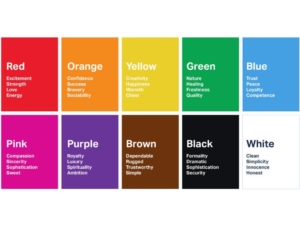Color Psychology in Marketing
In the world of digital marketing, the strategic use of color can be a game-changer. Colors have the power to evoke emotions, convey messages, and influence consumer behavior. Understanding the psychology of color in marketing is crucial for crafting a brand identity that resonates with your target audience. In this blog post, we’ll explore the significance of color in marketing and provide tips on choosing the right palette for your brand.
Exploring Color Psychology in Marketing
Color psychology in marketing delves into the impact of various colors on human perceptions and emotions. Different colors can elicit specific feelings and associations, rendering them a potent tool in the realm of marketing. Below are some common associations with colors:
- Red: Frequently linked with passion, vitality, and a sense of urgency, red can be harnessed to seize attention and cultivate an atmosphere of excitement.
- Blue: Conveying trustworthiness, reliability, and serenity, blue is a favored choice for many technology and finance companies seeking to establish credibility.
- Green: Symbolizing growth, well-being, and a connection with nature, green is often embraced by eco-friendly and wellness-oriented brands.
- Yellow: Representing optimism and joy, yellow has a knack for grabbing attention and is often employed to emphasize important information.
- Black: Often associated with sophistication, luxury, and formality, black is the choice of many high-end brands.
Choosing the Right Color Palette for Your Brand
When selecting the ideal color palette for your brand, several key considerations come into play. Each of these considerations is crucial in ensuring that the colors you choose align with your brand’s identity and resonate effectively with your target audience. Let’s delve into each of these considerations in more detail:
Audience Insights and Color Psychology
Understanding your audience is paramount in the color selection process. To effectively choose colors that resonate with your audience, delve into their preferences and the associations they make with colors. Consider demographics, cultural backgrounds, and the emotions your audience associates with different hues. Comprehensive audience research can provide valuable insights into the colors that are most likely to engage and connect with your potential customers.
Brand Personality Understanding
Every brand possesses a unique personality and set of core values. Define your brand’s character and use color psychology in marketing. Is it playful, professional, eco-conscious, or something else entirely? Your brand’s personality should guide your color choices. For instance, a fun and youthful brand might opt for vibrant and lively colors, while a professional, corporate brand may lean towards more subdued and classic hues. Your color selections should authentically reflect your brand’s personality and messaging.
Color Combinations
Don’t restrict yourself to a single color. Think beyond monochromatic choices and consider color combinations. Combining multiple colors in a harmonious way can provide depth and dimension to your brand identity. These combinations should not only work well together visually but should also authentically represent your brand’s values and persona. It’s essential to strike a balance that enhances your brand’s visual appeal while maintaining consistency.
Competitive Analysis
To stand out in a crowded market, it’s vital to be aware of the color choices made by your competitors. Analyze their branding and marketing materials to ensure your color scheme differentiates your brand. You don’t want to blend in with the crowd; your chosen colors should help you capture attention and be memorable in the minds of your customers. By examining your competitors’ color choices, you can strategically position your brand to set it apart from the rest.
Testing and Iteration
Selecting the right colors is not a one-time decision; it’s an ongoing process that benefits from continuous improvement. A/B testing is a valuable tool to determine the most effective colors in your marketing materials. It involves experimenting with different color choices and measuring which ones yield the best results. Regular testing and iteration allow you to refine your color choices based on data and user feedback, ensuring that your brand’s color palette remains optimized for engagement and conversion.
The psychology of color plays a crucial role in shaping consumer perceptions and driving engagement. Choosing the right color palette for your brand can help you convey your message effectively and build a strong brand identity. By understanding the emotional and psychological impact of colors, you can make informed decisions that resonate with your target audience and set your brand apart in the digital landscape.




